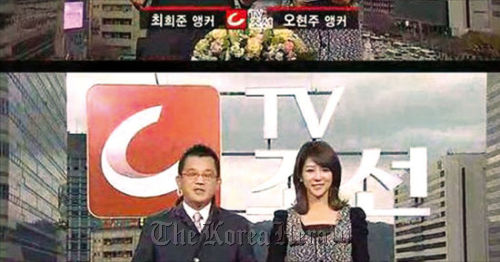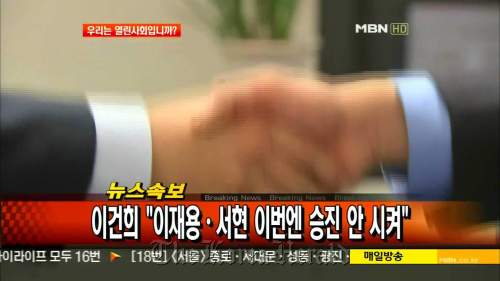Technical glitches, frequent program reruns dampen expectations for the cables operated by print media firms
All that flashy advertisement and promises of “a new television era” were brought to shame, at least in the first few days after new pay-television channels went on air here.
Instead of mega-sized soap operas and high quality variety shows that had been promised, viewers were left with broken and frozen frames, several minutes of sudden muteness, if not a complete empty signal.
“For a moment there, I thought my television was the problem,” said Seo Jae-hee, a 32-year-old housewife who says she had looked forward to the new channels despite the lingering controversy. “The contents of the programs were very disappointing too.”
Four new general programming cable TV broadcasters ― Channel A, ran by Dong-A Ilbo, TV Chosun, ran by the Chosun Ilbo, jTBC, ran by JoongAng Ilbo and MBN, ran by the Maeil Business Newspaper ― went on air Dec. 1.

All that flashy advertisement and promises of “a new television era” were brought to shame, at least in the first few days after new pay-television channels went on air here.
Instead of mega-sized soap operas and high quality variety shows that had been promised, viewers were left with broken and frozen frames, several minutes of sudden muteness, if not a complete empty signal.
“For a moment there, I thought my television was the problem,” said Seo Jae-hee, a 32-year-old housewife who says she had looked forward to the new channels despite the lingering controversy. “The contents of the programs were very disappointing too.”
Four new general programming cable TV broadcasters ― Channel A, ran by Dong-A Ilbo, TV Chosun, ran by the Chosun Ilbo, jTBC, ran by JoongAng Ilbo and MBN, ran by the Maeil Business Newspaper ― went on air Dec. 1.


The four channels provide nationwide coverage in a country where more than 80 percent of households have cable or other kinds of pay-television connection, meaning they are theoretically able to compete with the three terrestrial channels.
Yonhap News Agency, Korea’s key news service, was the sole winner of the license for an all-news cable television channel and its broadcast arm, News Y, also went on air Dec. 1.
But the quality of the new channels was much below expectation.
All four general programming channels had disconnection problems on the very first day, airing President Lee Myung-bak’s congratulatory message with buzzing sounds and broken screens.
TV Chosun went as far as having its frame being divided into two for several minutes soon after going on air.
“It was kind of annoying and hilarious at the same time,” said Oh Tae-soo, a 29-year-old office worker. “I thought the channels were on test or something.”
An official at TV Chosun said the channel was “working to improve the broadcasting conditions,” declining to comment further.
The media industry had already raised concerns about the quality of the content given the insufficient time for preparation.
Aside from Maeil Business Newspaper, which was already operating a news channel, these consortiums are newcomers to the broadcasting industry and apparently did not conduct enough testing for technical problems.
News Y, which had boasted it would be an “all-day news channel,” drastically reduced its broadcasting hours due to the lack of file pictures and equipment.
It currently airs Korean-language news five hours a day, followed by two five-minute slots of English-language news.
“It’s not due to the lack of content,” an official at the news channel said over the telephone, asking not to be named due to the sensitivity of the issue for his firm. “We are just waiting for some more equipment to arrive to start airing news 24 hours.”
A staff at the English-language service, who also asked not to be named, admitted there hadn’t been enough time for preparation.
“Everything was changed at the last minute with the team losing the whole system over the weekend,” the staff said. “The quality of the first broadcast was frankly similar to that during the rehearsals.”
With these problems, the new channels are each suffering from much-lower-than-expected viewership.
Three programs aired on jTBC were the only shows to rate above 1 percent viewership, while other broadcasters stayed far below.
Despite the criticism and apparent disappointment of the audience, the four newspapers continued to toot their own horns about their respective channels, claiming victory over one another.
The papers also insisted their prime time news had garnered the largest amount of viewers with Chosun Ilbo quoting survey group TNmS and JoongAng quoting AGB Nilson Media Research. Dong-A Ilbo published three long articles over the weekend that insist Channel A aired “exclusive and interesting scoops” related to a popular entertainer and recent trends.
Chosun Ilbo used up a large portion of its entertainment section on Dec. 3 to advertise TV Chosun’s upcoming dramas and variety shows.
All five channels, considered right wing and pro-government, aired special interviews with Park Geun-hye, considered the strongest conservative candidate for next year’s presidential elections, sparking debates about their potential political and ideological impact.
It’s hard to say which channels are most likely to survive, experts say, noting how SBS, the country’s youngest terrestrial channel that went live in 1991, had also suffered poor viewership for years before its 1995 miniseries, “Hourglass,” became a hit.
“Only two of the channels are likely to survive in the next three to five years,” said Professor Cho Sung-ho of Kyungpook National University. “But it’s way too soon to say which.”
By Shin Hae-in
(hayney@heraldcorp.com)







![[Graphic News] More Koreans say they plan long-distance trips this year](http://res.heraldm.com/phpwas/restmb_idxmake.php?idx=644&simg=/content/image/2024/04/17/20240417050828_0.gif&u=)
![[KH Explains] Hyundai's full hybrid edge to pay off amid slow transition to pure EVs](http://res.heraldm.com/phpwas/restmb_idxmake.php?idx=644&simg=/content/image/2024/04/18/20240418050645_0.jpg&u=20240419100350)







![[KH Explains] Hyundai's full hybrid edge to pay off amid slow transition to pure EVs](http://res.heraldm.com/phpwas/restmb_idxmake.php?idx=652&simg=/content/image/2024/04/18/20240418050645_0.jpg&u=20240419100350)

![[Today’s K-pop] Illit drops debut single remix](http://res.heraldm.com/phpwas/restmb_idxmake.php?idx=642&simg=/content/image/2024/04/19/20240419050612_0.jpg&u=)